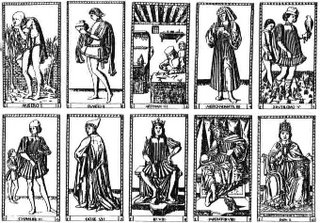
As I biked around the desert playa of Burning Man during the festival as a culmination of my summer research, I wrestled with understanding the essence of the event. I recognize the incredible complexity of this cultural and social phenomenon and that any such understanding must resist oversimplification to the point of misunderstanding.
A number of elements which comprise the Burning Man experience have been suggested, and several come from the Burning Man
website itself. These include a sense of
belonging as a part of a group;
survival in a hostile desert environment;
empowerment through art and other forms of personal expression;
sensuality as it relates to the festival serving as a feast for the senses;
celebration through performance art and the burning of the Man; and
liminality which understands the festival as a threshold event in time, space, and culture. Frost and Hirsch have recognized and commented on these facets of Burning Man in their fine book on missional Christianity,
The Shaping of Things to Come (Hendrickson/Strand, 2003). In addition, I would add the strong emphasis on
art and
festivity, but these might be considered subsets of sensuality and celebration (although festivity might be understood much more broadly and with greater social and theological significance than celebration).
But even with these elements in my my questions remained as to the essence of Burning Man. Previously I thought I had boiled it down to either art or festivity as the key elements, and then wondered whether one gave rise to the or whether they should be recognized as occurring in tandem without one being an epiphenomenon of the other. In my earlier thinking I leaned toward festivity giving rise to the art, a point of view which runs counter to much of the thinking on this event. I hope to include a future post on Burning Man and festivity which will discuss this further.
But last night I was reminded how curiously seemingly unrelated strands of research and thinking can come together to shed new light on research. I have commented in the past on symbolic anthropology as it relates to understanding Latter-day Saint pageants and temple openings. Much of my thinking here has been influenced by the work of the late Victor Turner. In reviewing some of this previous research I became convinced that it is also directly relevant to understanding
a if not
the key element of Burning Man.
Researchers into the Burning Man phenomenon often point to community as a major facet of the appeal of the festival. I believe this is a step in the right direction but it does not go far enough. Burning Man holds great appeal and significance as a social and cultural experience because it offers far more than community, it offers what Turner called
communitas.
Victor Turner was a symbolic anthropologist who did some groundbreaking work in Africa studying the place of rituals and their symbolic meaning. He studied initiation rites and their role in the social situations of given tribal cultures. Turner noted that in these rites the participants pass through a liminal state of transition from their previous place of social location in the tribe to eventually transition to a new social location of the mainstream on the other side of the threshold. Turner’s work was fascinating in that he noted that the experience of the participants in the liminal state resulted in an intense feeling of intimacy among the participants. Turner saw this as an experience that approximated what occurs in religious events and he described the strong liminal experience of social togetherness of the initiates as
communitas.
Turner’s insights are valid both in non-Western societies in which he first observed them as well as in Western societies. He noted that societies include the stability of normal life, or "structure" as well as communitas that might be labeled “anti-structure.” Turner’s explanation of this juxtaposition of these elements illustrates much of what can be seen at Burning Man in terms of the social forces that under gird and energize the creative expression of the festival:
“I have used the term ‘anti-structure’ . . . to describe both liminality and what I have called ‘communitas.’ I meant by it not a structural reversal . . . but the liberation of human capacities of cognition, affect, volition, creativity, etc., from the normative constraints incumbent upon occupying a sequence of social statuses.”
Understand what Turner is saying: the strong feelings of community in the liminal state results in a liberation that affects human thinking and creativity that is not often found normal social situations. Communitas is a key facet to understanding both the increasing popularity of Burning Man itself, and what is often lacking in Chrisitan community in Western Christendom. Consider the following:
1. While Christian churches often experience a sense of community, rarely do they experience the intensity of communitas. We need not think in either/or terms, but the church might consider the significance of the community/communitas distinction.
2. Community tends to be inward focused and follows from a sense of working together as a result of a focus on each other and common goals; whereas the intensity and strong social bonds of communitas come from an outward focus of people working sacrificially toward a task.
3. Community can be artificial as people come together through shared beliefs, history and ideals, whereas communitas occurs naturally and intensely through shared experience.
4. Communitas has far greater potential to unleash creative thinking and artistic expression, elements desperately needed in Western Christendom.
5. If Christians in the West moved outside of community concepts in order to enter the liminal spaces of culture, the result would likely be communitas resulting in societal change both within local churches and the broader culture as well.
Michael Frost has recognized the importance of communitas to missional expression in the West, as spurned on by his association with Alan Hirsch. Missional Christians are encouraged to reflect on this idea further both as an aid to understanding the citizens of Black Rock City and as a means of transformation and empowerment for Christian communities.
Michael Frost,
Exiles: Living Missionally in a Post-Christian Culture (Hendrickson/Strand, 2006)
Victor Turner,
The Ritual Process: Structure and Anti-structure (Aldine, 1969)
Victor Turner,
From Ritual to Theater: The Human Seriousness of Play (PAJ Publications, 1982)
Image source: Copyright Burning Man LLC, Michael Stewart – photographer







